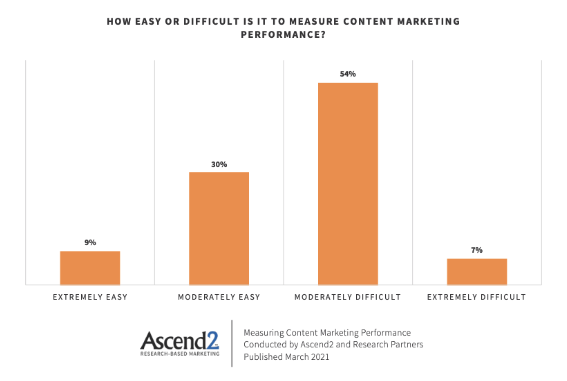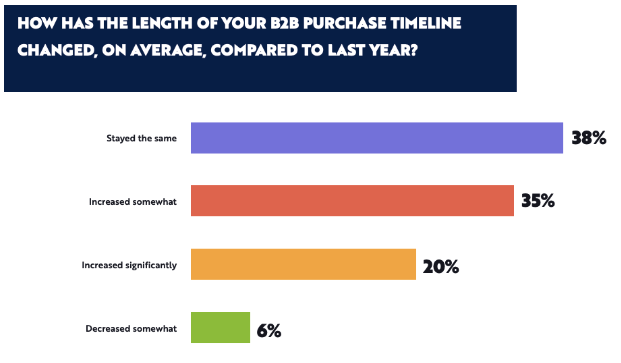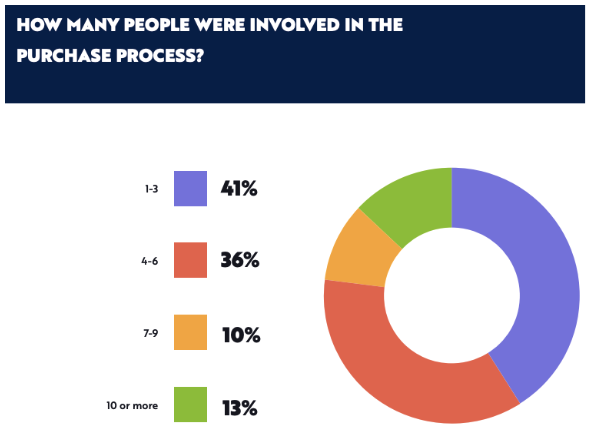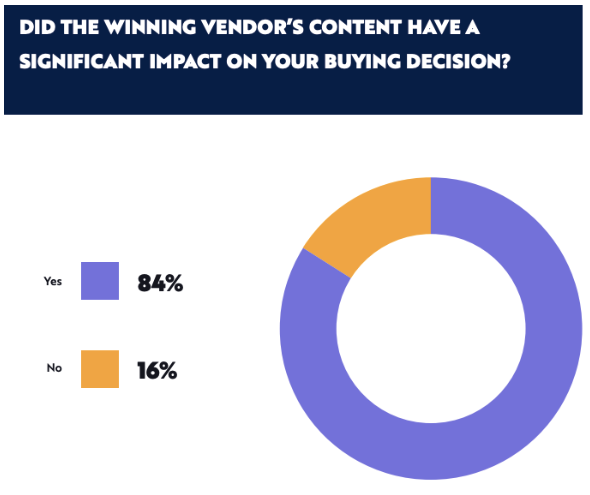It seems we all implicitly understand the value of high-quality content.
According to SEMRush, an astonishing 97% of brands say content marketing forms an important part in their overall marketing strategy, while more than half describe the maturity of their content marketing strategies as “fairly developed” or “advanced.”
But there’s a problem: The real-world value of content marketing — in terms of tangible results like leads, sales, and revenue — is notoriously difficult to demonstrate, let alone prove.
Research from Ascend2 found that 61% of marketers believe measuring the performance of content marketing is a challenging process, with 54% describing it as “moderately difficult” and 7% as “extremely difficult.”

What’s going on? Why do we, as professional marketers, struggle to explain the impact of our work? The struggle is even more surprising when you consider that content plays a crucial role in almost all digital marketing tactics, from social media ads to SEO.
It turns out there are actually myriad reasons why it’s hard to prove the value of content, with Ascend2’s survey highlighting the following top five factors:
- Lack of budget and/or resources (cited by 46% of respondents)
- Difficulty determining content marketing ROI (44%)
- Insufficient data (39%)
- Lack of a unified strategy (28%)
- Insufficient attribution model (24%)
In this article, I’m going to focus on #2 on the list: How can you understand the return on investment generated by your content marketing activity?
Why Is Measuring Content Marketing ROI So Difficult?
To be clear, it’s not because content marketers are a bunch of creatives with no business sense. There are several practical, hard-to-overcome challenges standing in the way of any attempt to ascertain the true value of content. Here are three of the biggest issues:
Buying Journeys Are Getting More Complex
In many ways, the digital age has made marketing easier. It’s given us access to near-infinite quantities of data to better understand our current and future customers, and it’s spawned the creation of multiple platforms and channels through which we can reach them.
But it’s also caused a whole bunch of problems that make it extremely difficult to measure content marketing ROI.
Buyers now have access to more information than ever before. Every day, they’re bombarded by ads for the latest products and services. Technologies are increasingly complex and sophisticated, making it harder for buyers to understand exactly what they need — or even to accurately sum up the business challenge they’re facing.
All of which means that buyer journeys are growing longer. According to Demand Gen Report’s (DGR’s) latest B2B Buyer Behavior Survey, 55% of buyers said their purchase timeline increased year on year, while only 6% said it decreased somewhat. None reported significant decreases.
Longer buying journeys inevitably result in more marketing touch points. Throughout their path to purchase, a buyer might encounter dozens of pieces of content, from top-of-the-funnel gated content to bottom-of-the-funnel case studies.
With all of that content consumed, how can you possibly deduce the value of a single piece of content?
Buying Committees Are Expanding
Adding to the difficulty in measuring content marketing ROI — and yet another reason for the ever-growing length of buying journeys — is the expanding size of buying teams.
DGR’s research shows that three-fifths of buying committees now contain four or more people, while one-quarter contain 7+ people. More than one in eight committees are made up of a headache-inducing 10 people or more.
Naturally, it takes longer to persuade multiple people to purchase than it would a single buyer.
But this isn’t just about the length of buying journeys. Every person on a committee will take their own path to conversion.
You might need to convince every single committee member before they’re ready to sign off on your product or service. Each of those buyers may come from a different background and have different levels of knowledge. You’re unlikely to persuade every one of them with a single case study or explainer video.
This muddies the waters even more. How can you say, with any degree of confidence, which piece of content had the biggest impact on the group’s buying decision? If the CEO skim-reads a blog post, is that “action” more valuable than the VP of Sales downloading an ebook and watching a product demo?
You may be able to make educated guesses about the value of an individual piece of content — and attribution models may be able to help here — but those insights might only be applicable to a single buying journey, with little or no relevance to future sales.
Content Interactions Rarely Lead to Direct Sales
Finally, we come to one of the most glaring challenges of proving content marketing ROI: Sales can rarely be traced directly to content interactions.
Realistically, B2B buyers aren’t going to read a blog post then immediately make a purchase.
More likely, each buyer will consume numerous pieces of content from various brands before coming together as a committee and reaching a decision. Even if you are able to use complex attribution models, can you really prove — with any real degree of confidence — that a single blog post your buyer read six months ago had a meaningful impact on their purchase decision?
This challenge is further complicated by the thorny subject of sales and marketing alignment.
Unless you have a 100% self-serve sales process, it’s likely down to your sales team to close the deal. That means the performance of individual salespeople becomes a factor in the effectiveness of your content marketing efforts.
If you generate a ton of qualified leads but the salesperson doesn’t close them, that’s not a reflection on the quality of your marketing — but in real terms, it’ll look like all your content delivered precisely zero return on investment.
So Is Content Marketing ROI Impossible to Demonstrate?
Sounds like it’s an open and shut case. We can’t realistically hope to measure content marketing ROI with any real specificity.
So should we all just give up and go home? Accept that it’s totally impossible to prove content’s value? Hang up our keyboards, Photoshop certifications, and video cameras for good?
Let’s not be too hasty, because there’s another tantalizing tidbit in DGR’s research: a stunning 84% of buyers said the winning vendor’s content had a significant impact on their buying decision, up from 79% in 2021.
What’s more, when buyers visit a vendor’s website, they’re most likely to want:
- Easy access to relevant content that speaks directly to their company (cited by 63% of buyers)
- Easy access to pricing and competitive information (62%)
- Information that speaks directly to, and demonstrates expertise around, the needs of their industry (56%)
Doesn’t that sound an awful lot like content marketing?
So content marketing clearly plays a massive role in the buying journey. We know this because buyers tell us it’s true. Yet most marketers struggle to measure the performance of their content, and there are multiple factors that make it near-impossible to prove the value of a single piece of content.
It’s Schroedinger’s ROI.
But what can we actually do about it?
How Can Marketers Discuss Content Marketing ROI?
If we can’t accurately measure content marketing ROI, what can we do instead to understand how, when, and to what degree we should be investing in content? And how do we persuade the C-suite that content marketing is worth all the time and money?
Here are five approaches to help you reframe the conversation around how content marketing contributes to your business goals.
1. Define Exactly What You Want Content to Achieve
The first step to proving content marketing ROI is to define specific goals.
Of course, we’d all like to generate five sales from every blog post we publish, but that’s probably not going to happen. Instead, focus on realistic objectives. How can content contribute to your overarching objectives?
For instance, say your organization is targeting a new vertical. It’s not practical to commit to generating a fixed amount of revenue from customers in that vertical through content marketing alone. But it’s definitely achievable to build authority within that niche by writing blog posts targeting relevant keywords, generating backlinks to those articles, and creating guest posts for authoritative niche websites.
Once you’ve defined a plan, you can set KPIs to measure performance, such as:
- Rankings for specific keywords
- Number of backlinks from high-authority sites
- Traffic volumes to niche blog posts
Importantly, the leadership team needs to buy into these KPIs and agree that they contribute to business growth. If you can do that, you’ll effectively “prove” the ROI of your content marketing efforts by hitting your KPIs.
2. Consider Non-Traditional Marketing Metrics
As content marketers, we can’t rely entirely on “traditional” marketing metrics like traffic and revenue.
They might show that people are reading your content. But they probably won’t prove that a blog post or video has a direct, meaningful impact on your bottom line.
So it pays to consider non-traditional metrics as well.
For instance, at Content Conquered, we once worked with a client who measured the performance of their content based on the number of people who told them, “I feel like I’m seeing you everywhere!”
Their thinking was simple: The more people who reached out, the more brand awareness they were generating.
Of course, there are lots of other non-traditional metrics that can help demonstrate your content marketing ROI. Tim Soulo, CMO at Ahrefs, gave a bunch of examples in a lengthy Twitter thread.
Let’s talk about the “ROI of Content Marketing.”
Far too often us marketers get challenged with this question by our boss (or our client):
– How do I know that my investment in content will guarantee a positive return? …& how can I *MEASURE* it?
[Read more..]
— Tim Soulo 🇺🇦 (@timsoulo) March 23, 2021
Among others, they included:
- Taking the strain off your customer support team. How many users find answers in your FAQ section or resource hub? How many immediately go on to contact customer support (and how many don’t)?
- Fuelling revenue expansion from existing customers. How many customers upgrade their plans or try out new features after reading or watching educational content?
- Contributing to the “mere-exposure effect.” Otherwise known as the “familiarity principle,” this is the psychological phenomenon by which we develop preferences for things that are familiar to us. The more of our content people consume, the more likely they are to like us!
3. Differentiate the Needs of Different Stakeholders
The best approach here is to consider the requirements of individual stakeholders.
C-level leaders need cold, hard data to allocate budget. So do your best to give it to them. While revenue will always be their biggest priority, each likely needs different information to persuade them that your content marketing program is delivering. How can you demonstrate that you’re delivering the results they desire?
For example, what does your Chief Revenue Officer need from your content? Is their “version” of content marketing ROI best demonstrated through a traditional metric, like the volume of qualified leads generated in a given time period? Or is it more relevant to demonstrate that you’re supporting the revenue team by creating a given number of deliverables within a specific time period?
List each member of the C-suite and repeat the exercise until you’ve got a selection of meaningful figures that speak to the impact of your content marketing strategy.
This strategy works outside of the C-suite too. For example, when meeting with the sales team, identify what they need out of your content marketing. How can you show them you’re fulfilling their needs? What metrics do they care about?
4. Measure Bottom-of-the-Funnel ROI
Top-of-the-funnel (TOFU) content can be ethereal. It appears so early in the buying journey that there’s no real way to prove its impact.
I’ve already noted that it’s pretty much impossible to assign meaningful value to a single blog post that a buyer read six months ago. How many other blog posts have they read in that time? Ten? Twenty? Fifty? And how many of those websites can they even remember?
If it’s so difficult to measure the impact of TOFU content, maybe it’s best — in some cases — to not even bother.
Instead, you could focus on something that’s more controllable — content at the bottom of the funnel that is consumed just prior to a buying decision. Try answering questions like:
- How many product explainer video views translate into product demos?
- What impact does sharing industry-specific case studies have on conversion rates?
- When buyers check out your comparison page, do they reach out to your sales team or request a demo?
These are all things that can absolutely be measured. And because BOFU content is much closer to the (trans)action, it’s much easier to demonstrate that these results have a direct impact on your bottom line.
5. Treat Content as an Enabler, Rather Than a Separate Channel
We all agree that content marketing ROI is tough to demonstrate. So why not look at it from the opposite perspective: What would your wider marketing ROI look like without any content at all?
Content marketing is a nebulous term that means different things in different contexts. Among many other things, it includes:
- The ebooks you create to capture leads through social ads
- The blog posts that bring new audiences to your site through SEO
- The case studies that help your sales team convert leads into paying customers
If you ceased content creation overnight, I’m guessing those other sales and marketing channels would find their lives a whole lot harder.
To be clear, I’m not actually suggesting you stop creating content — it’s more of a thought experiment than an instruction.
But it offers you an alternative approach to better demonstrate the value of your content marketing.
Identify all the campaigns you’re currently running that are at least somewhat reliant on content marketing. Discard any campaigns that would work just as well without content, then add up the combined return of everything that’s left.
That figure offers a meaningful, if somewhat crude, insight into the real value of your content marketing efforts.
Just Because You Can’t Measure Something Doesn’t Mean It’s Broken
I’m going to wrap this up with a story.
Humankind has long known that bacteria and fungi can kill, or inhibit the growth of, other microbes. Some believe it’s why ancient Egyptians treated infected wounds by applying moldy bread. But it wasn’t until the discovery of penicillin in 1928 that we could truly measure and understand the impact of antibiotics.
Does that mean the ancient Egyptians were wrong? Should the pharaohs have slashed their medical budgets due to a lack of demonstrable ROI? Clearly not; they had enough evidence to know their approach was working, even if they couldn’t prove it.
The same is (basically) true of content marketing. You know other channels are reliant on a regular stream of high-quality content. You know it plays a vital role in the buying journey. You know that you’d fall behind your competitors if you stopped investing in content.
Maybe that’s all the proof you need.



